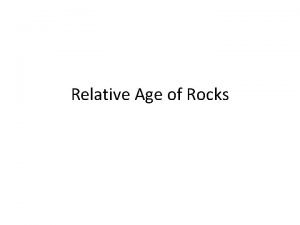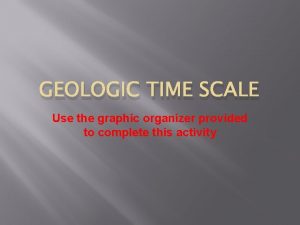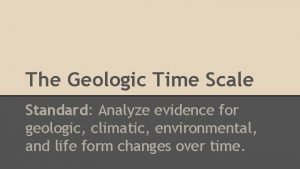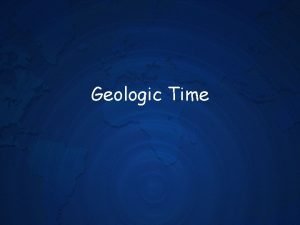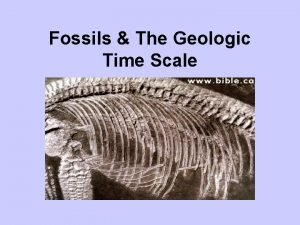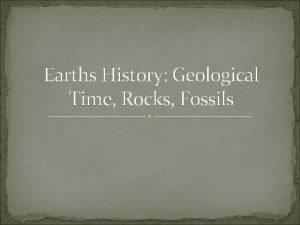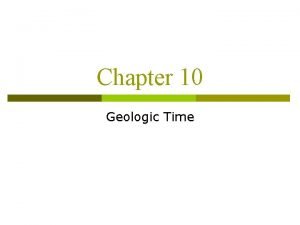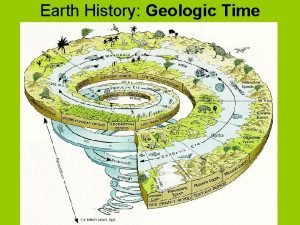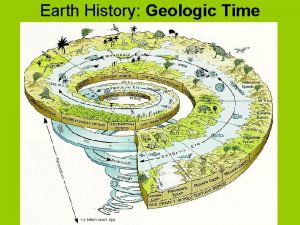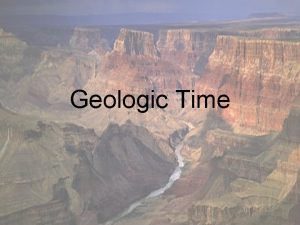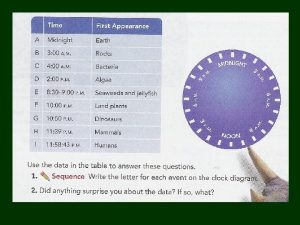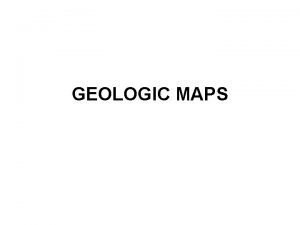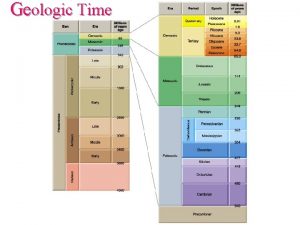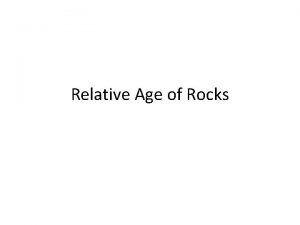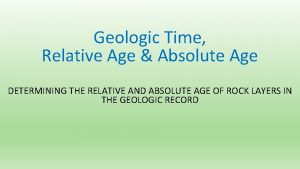Relative Age of Rocks and the Geologic Time












- Slides: 12

Relative Age of Rocks and the Geologic Time Scale

Absolute and Relative Age The absolute age of a rock is how long it has been since the rock has formed. The relative age of a rock is how old it is compared to the rocks around it. How Scientists Determine Relative Age • • The Law of Superposition Intrusions and Exclusion Fault line changes Index Fossils

The Law of Superposition According to the law of superposition, in horizontal sedimentary rocks, the lowest layer is at the bottom, and each higher layer is younger than the layers below it. The lowest layer of rock will have the oldest fossils. The highest layer of rock will have the most recent fossils.

Intrusions Magma is molten, flowing rocky material beneath the earth’s surface. Magma can push into sedimentary layers and harden into solid rock. This rock is called an intrusion. Intrusions are younger than the layers they push through.

Intrusion Formation Layer E – Scientists need to use other clues to find out if this layer is older or younger than the intrusion. Intrusion DAn intrusion happens after Layer C is formed Layer C is made of sediment that builds up on Layer B is made of sediment that builds on Layer A forms – it is the oldest layer

Extrusions When magma flows to the surface it is called lava. It can harden into rock. When lava hardens on the surface of the Earth, it can even form a horizontal layer in the same way sediment can. This is called an extrusion. An extrusion is always younger than the rocks below it.

Extrusion Formation Layer E – This layer is definitely younger than the lava extrusion Extrusion DLava cuts through the first three layers and forms a layer on top of C Layer C is made of sediment that builds up on Layer B is made of sediment that builds on Layer A forms – the oldest layer

Fault Line Changes A fault is a break in the Earth’s crust. The fault is always younger than the rock it cuts through. To determine the relative age of the fault, geologists find the relative age of the youngest layer cut by the fault. The fault causes layers to no longer line up. Solid layers, like layer E, can be built up evenly after the fault has changed.

Uncomformities (not nonconformities) Unconformities appear when something happens to the horizontal layers of sediment. The layers can be changed or some layers can be missing. When the top layer of sedimentary rock is eroded and then new sediment is deposited where the layer used to be, there is a gap in what geologists can learn. The rock can be folded by converging plates or molten magma can shift the layers so they are angled or wavy.

Index Fossils Index fossils are specific fossils that occur across large areas and only lived for a short time. Index fossils are helpful because they tell the relative ages of the rock layers in which they are found. Scaphites only lived between 145 and 65 million years old. Layers with Scaphites and the fossils in those layerscan only be that old.

The Geologic Time Scale is a record of life forms and geologic events through the Earth’s history. Scientists first created the Geologic Time Scale by studying rock layers and index fossils worldwide. The Geologic Time Scale is divided into units of time called eras and periods.

 Compare geologic time with the geologic column.
Compare geologic time with the geologic column. Igneous vs metamorphic
Igneous vs metamorphic Igneous metamorphic and sedimentary
Igneous metamorphic and sedimentary Marli miller
Marli miller Relative age dating
Relative age dating Stone age chronology
Stone age chronology Iron age bronze age stone age timeline
Iron age bronze age stone age timeline Earth's history and geologic time graphic organizer
Earth's history and geologic time graphic organizer How is the geologic time scale organized
How is the geologic time scale organized Geologic time scale in a calendar year
Geologic time scale in a calendar year Geologic time scale animals
Geologic time scale animals Fossils
Fossils Geologic time scale drawing
Geologic time scale drawing



